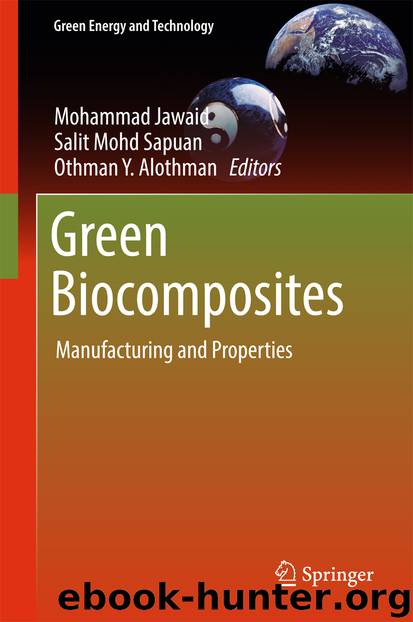Green Biocomposites by Mohammad Jawaid Salit Mohd Sapuan & Othman Y. Alothman

Author:Mohammad Jawaid, Salit Mohd Sapuan & Othman Y. Alothman
Language: eng
Format: epub
Publisher: Springer International Publishing, Cham
2 Wood and Non-wood Particles
Wood particles are usually used in particleboard and WPC manufacturing. The term particle is a generic term applied to all lignocellulosic elements, either wood or non-wood, from which composites are made. The terminology can be referred to various types of particles depending on their applications. For example, the major types of particles used in particleboard manufacturing include wood shavings, flakes, wafers, chips, sawdust, strands, slivers, and wood wool (Moslemi 1974). Meanwhile the major types of particles used in WPC are commonly called fibre, particle, wood flour and sometime sawdust. Wood flour and sawdust are the same product, but in different size where the sawdust is normally having smaller size as compared to the wood flour. As reported by Loss (2013), wood dust covers the range from millimetres down to less than 0.1 μm. Particles larger than about 10 μm do not remain suspended in air for long, however particle with 10 to less than 1 μm sizes are able to enter airways which can eventually cause serious health problems (Loss 2013). In present work, most of the particles used for particleboard and WPC are mostly at larger size with more than 10 μm. These particles can be obtained from wood and non-wood species.
Wood can be categorized into hardwood and softwood, respectively. Botanically, hardwood are woods that come from angiosperms (flowering plants) with vessel element (or pore), and softwoods are those woods that come from gymnosperms (mostly conifers) with lack of vessel element (Wiedenhoeft and Miller 2005). Wood is a major raw material used for particleboard and WPC production, which accounted for 95 % of the lignocellulosic material available (Ghalehno et al. 2011a, b). In tropical countries, particularly in Malaysia, rubberwood is a main raw material for wood composite such as particleboard production (H’ng et al. 2012). While, in temperate countries, pine and poplar wood are favoured species that used in particleboard and WPC manufacturing. As the global supply of wood depleting continually, attention has been shifted to non-wood particles in particleboard production. Non-wood plants consist of dicotyledonous and monocotyledonous plants and can be categorize into various classification. In recent study done by Paridah et al. (2015), they have classified the non-wood plants into two main groups namely conventional plant fibres (cotton, kapok, flax, jute, hemp, ramie, kenaf, sisal, abaca, henequen, coir, and bamboo) and non-conventional plant fibres or agro-based fibre residues (corn stalk, wheat straw, rice straw, rice husks, sugarcane/bagasse, pineapple leaf, banana pseudostem, coconut stem, oil palm fibres). These two materials (wood and non-wood) are gaining attention from researchers and can be processed into particles to produce particle based green composites. A rough inventory of potential fibre resources available in world are done by Rowell (2008). According to the author, wood is a major source of fibre (1750 million dry tonnes), however, the sources of non-wood are also equally important as the combined value of these non-wood materials are greater than wood (2283 million dry tonnes).
Download
This site does not store any files on its server. We only index and link to content provided by other sites. Please contact the content providers to delete copyright contents if any and email us, we'll remove relevant links or contents immediately.
International Integration of the Brazilian Economy by Elias C. Grivoyannis(85583)
The Radium Girls by Kate Moore(11863)
Turbulence by E. J. Noyes(7891)
Nudge - Improving Decisions about Health, Wealth, and Happiness by Thaler Sunstein(7456)
The Black Swan by Nassim Nicholas Taleb(6943)
Rich Dad Poor Dad by Robert T. Kiyosaki(6311)
Pioneering Portfolio Management by David F. Swensen(6167)
Man-made Catastrophes and Risk Information Concealment by Dmitry Chernov & Didier Sornette(5874)
Zero to One by Peter Thiel(5633)
Secrecy World by Jake Bernstein(4591)
Millionaire: The Philanderer, Gambler, and Duelist Who Invented Modern Finance by Janet Gleeson(4289)
Skin in the Game by Nassim Nicholas Taleb(4121)
The Age of Surveillance Capitalism by Shoshana Zuboff(4115)
The Money Culture by Michael Lewis(4022)
Bullshit Jobs by David Graeber(3988)
Skin in the Game: Hidden Asymmetries in Daily Life by Nassim Nicholas Taleb(3866)
The Dhandho Investor by Mohnish Pabrai(3632)
The Wisdom of Finance by Mihir Desai(3603)
Blockchain Basics by Daniel Drescher(3428)
